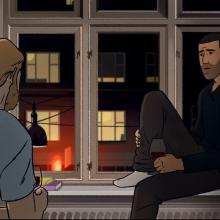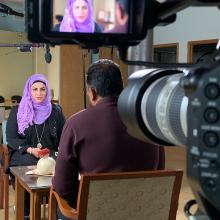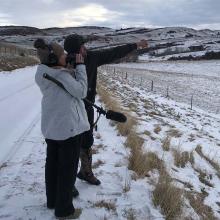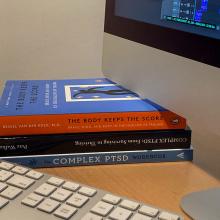Recent years have seen a surge in documentary productions and a growing popularity of documentary film among audiences worldwide. Despite this encouraging development, however, disempowering colonialist legacies linger on within the documentary craft and narrative, resulting in a number of films that are largely exploitative and reductionist. In the hopes of scrapping the historical framework of exploitation, activists and filmmakers have been calling for the reimagining of the nonfiction ethos, built on the values of responsible authorship and accountability. The 64th edition of the
Latest Posts
At the end of August 2021, the images of frantic Afghanis crowding Kabul airport were a stark reminder of the despair with which people flee their homeland in search of a safer future. The news unfortunately continues to provide us with a daily litany of tragic images: Haitian refugees rebuffed with whips at the border, North Africans shipwrecked off the tiny island of Lampedusa, or Kurdish women and children drowning in the frigid waters of the English Channel in the hopes of reaching more hospitable shores. For many refugees, each stage of their fraught journey threatens to be their last
Screen Time is your curated weekly guide to excellent documentaries and nonfiction programs that you can watch at home. Like everyone else, the Documentary team has been deeply mourning the passing of Broadway titan Stephen Sondheim, but we’ve also been celebrating his life by playing and replaying soundtracks from his musicals, and watching documentaries that honor his amazing legacy. No surprises here, but DA Pennebaker's 1970 documentary, Original Cast Album: “Company" tops our list. The film, as legendary as the eponymous musical, was long unavailable, but you can now watch it on Criterion
Nearly six years ago, in 2016, a story out of Rutherford County, Tennessee became something of a national outrage, although many of us missed the news. Four Black girls — one in sixth grade, two in fourth grade, and one in third grade —were arrested at school for a crime that a recent ProPublica article suggests was illegitimate. Apparently, the children watched and were accused of doing little to stop a “fight” in which a five- and a six-year-old boy threw feeble punches at an older child. And as a result, the children were accused of the trumped-up charge of “criminal responsibility”—for a
Dear Readers, What the past 20 months have unleashed upon the world underscores the urgency to center trauma and mental health in our ongoing conversations, and in this issue of Documentary. This past winter, we published a first-person account from cinematographer Jenni Morello about her experiences filming in troubled regions—and her struggles to address the traumas that ensued. Morello’s account inspired us to inquire about other trigger-laden phases of documentary filmmaking, such as post-production. We reached out to seasoned editor Miranda Yousef, who discusses her own experiences
Dear Documentary Community, As the documentary financing business model continues to evolve, so have the strategies that filmmakers must pursue in order to secure meaningful funding for their important work. While the first hurdle we all have in common is in being able to actually secure a meeting or gain access to financiers in the nonfiction space, a key part of this process, once you are face-to-face, involves establishing relationships with these funders beyond the transaction. It was already extraordinarily challenging for documentary filmmakers to find the money they needed to make their
When Nick Stuart of the nonprofit multimedia company Odyssey Impact thinks back on the 2016 world premiere of Kim A. Snyder’s Peabody Award-winning documentary Newtown—which tells the story of the community in Newtown, Connecticut, after the mass shooting of schoolchildren at Sandy Hook Elementary School—he remembers a specific conversation with a shuttle driver. “We launched Newtown at Sundance, [where] the busses take people everywhere. They chatter away about what they’ve just seen. There was a bus driver I spoke to who said, ‘After your film, everyone came on to the bus in silence.’ It
Every November, for Native American Heritage Month (NAHM), the US commemorates the contributions, culture and history of Native people. It is also a month to reflect on how to honor the rich knowledge and stewardship passed on for generations by Native people, to which our nation is greatly indebted. Despite the long history of violence and disenfranchisement faced by Native American communities, the many issues that they continue to face today remain invisible to many Americans. Documentary films are one way to shed light on these important stories and to ensure that Indigenous voices are
It was the first day on my new editing gig: a feature documentary about abuse, directed by Amy J. Berg. The AE had delivered the hard drive, the project set up to my requested specifications. I began opening bins and scrubbing through footage, and very shortly ran headlong into very disturbing material: a character roaming around streaked with blood; a series of photos showing the antagonist pretending to stab the protagonist over and over; audio of a woman being beaten and screaming. Caught off-guard, I felt a very old panic rising in my chest, that same terror I used to feel right before a
IDA has announced grants, totaling $75,000, to three vérité short documentaries from Bhutan, Colombia and the United States through its IDA+XRM Media Incubator. The Incubator supports short vérité documentary films from around the globe, with an emphasis on emerging filmmakers and new perspectives.









